Puget Systems and iBUYPOWER: two sides of the system integrator coin
by Jarred Walton on February 15, 2007 10:25 AM EST- Posted in
- Systems
iBUYPOWER: Construction and Design Cont'd
High-End System
The use of a different case immediately changes the outward appearance a lot.
We prefer the appearance of the Thermaltake Armor Jr. to most of the other cases you can select in the configurator, but it still has a few problems. For one, the two hinged "doors" on the front panel are unnecessary and tend to get in the way. Every time you need to open the optical drive to insert or remove a disc, you have to move them out of the way. Some people might feel that they make the case look cool, but they definitely don't appear to have any useful purpose other than appearance.
The whole front panel can also swing open to allow access to the external drive bays, and this also gives easy access to the front 120mm fan for cleaning purposes. Much of the inside of the front panel also has foam filters in place to help keep dust out of the system, although directly in front of the fan does not contain a filter other than the metal grate on the front panel so dust will still be a problem. One issue with this hinged door design is that it doesn't latch as securely as we would like; when transporting the case, the front panel would frequently pop open a bit. A lock on the side can help to prevent this, but the case could still use something better than a simple plastic latch.
Similar to the midrange build, the high-end iBUYPOWER system once again has a large window dominating the left side of the case, and there's not much to see on the right side.
Most modern cases include USB ports and a couple audio jacks on the front of the case, but the Thermaltake design changes things up a bit. A top hatch pops open to reveal two USB ports, a FireWire port, and the microphone and headphone jacks. This type of design is generally best used when placed on the floor rather than on top of a desk, and whether or not you prefer it over front mounted ports is going to be a personal opinion.
Removing the left panel and taking a look at the Interior, you would hardly expect that these two systems were built by the same company. The change of case and power supply definitely contributes to the reduced cable clutter, but it also seems that iBUYPOWER might have taken a bit more time to make sure the interior was clean on this high-end configuration. The only way verify that would be to purchase a midrange computer with the Thermaltake Armor Jr. case (and probably a different power supply as well), but we'll give them the benefit of the doubt. The Thermaltake chassis certainly has a few more options for routing wires, so clean wiring will depend in part on what type of case you purchase as well as whether or not you get a power supply with sleeved cables. Some companies spend a bit more effort on making sure cables are really kept out of the way, but that sort of approach has other drawbacks -- if you ever need to change out a component, having all of the cables tucked away can make it far more difficult to accomplish.
There are also some other interesting aspects of the internal equipment. For one, there's a small water cooling heatsink on the CPU, although the size of the water reservoir is so small that it's difficult to imagine this will be much better than standard air cooling. (Don't be concerned with the radiator portion appearing to be dislodged -- that was something we had done prior to taking the pictures and forgot to correct.) The fan on the water block also serves as the rear case exhaust, although with only an 80mm fan it's not going to move as much air as a larger 120mm fan would. The mounting of the radiator on the rear of the case is also less than ideal, as the case is designed to accommodate a 120mm fan. Three screws are basically inserted through the honeycomb grill, and a fourth screw can't be used because the honeycomb perforations don't line up with the screw holes.
The two large graphics cards at the bottom of the case take up quite a bit of room, and iBUYPOWER didn't elect to install any other optional expansion cards. There's still room to add a sound card if you want, as well as a TV tuner, but it's going to be a bit cramped. That's part of the price you pay for high-end CrossFire or SLI configurations, unfortunately. The dual X1950 cards do have some positive aspects, however (besides performance). Both cards ventilate their hot air out the rear of the case, so they should improve airflow within the case and hopefully not contribute too much extra heat. The Gateway FX530 we looked at offered similar performance, but Gateway didn't use a standard X1950 CrossFire card due to space requirements.
Other than the power supply, the only remaining cooling is provided by the front 120mm fan. This fan also blows air across the three hard drives, so the system should be able to easily accommodate any hard drive configuration you wish to install. The dual Raptor drives along with a third mass storage drive are a good indication of what can be accomplished. The side-mounted hard drives also make it easier to install large graphics cards, and reaching the power and data connections on the drives is a lot more convenient as well. The power supply is still an NZXT model, but at least it has sheathed cables this time. It includes the dual PCI-E power connectors that are necessary for X1950 CrossFire, and there are plenty of other power connectors for the remaining devices in the system. Unfortunately, the power supply did fail during testing, but more on that later.
In contrast to the midrange system, the high-end iBUYPOWER setup is pretty impressive. It uses a better case and the wiring job was much cleaner. Considering that it includes more components, keeping everything uncluttered is even more difficult. Obviously, some time and effort went into putting the system together to make sure everything looked nice. If all of iBUYPOWER's systems looked like this on the inside, we would have no problem whatsoever recommending them, but for now it appears that your choice of case and possibly the price of your system will have an impact on how much effort goes into putting the system together. Perhaps iBUYPOWER should ditch their current 420W default PSU and upgrade all of their systems to something with sheathed cables, as that alone would help quite a bit in making the internals look better. Another option would be to eliminate the case windows, and as we mentioned already we wouldn't mind seeing a few less gaudy cases for selection in the online configurator.
High-End System
The use of a different case immediately changes the outward appearance a lot.
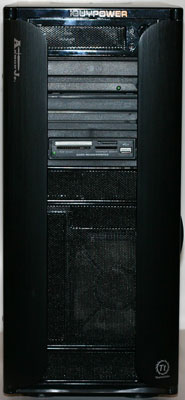 |
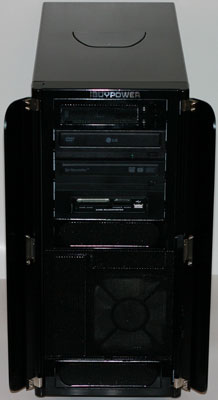 |
| Click to enlarge | |
We prefer the appearance of the Thermaltake Armor Jr. to most of the other cases you can select in the configurator, but it still has a few problems. For one, the two hinged "doors" on the front panel are unnecessary and tend to get in the way. Every time you need to open the optical drive to insert or remove a disc, you have to move them out of the way. Some people might feel that they make the case look cool, but they definitely don't appear to have any useful purpose other than appearance.
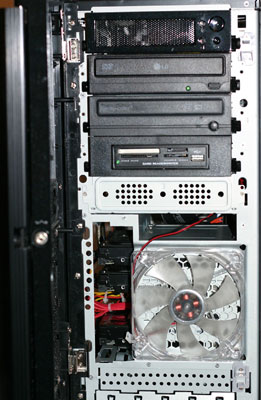 |
 |
| Click to enlarge | |
The whole front panel can also swing open to allow access to the external drive bays, and this also gives easy access to the front 120mm fan for cleaning purposes. Much of the inside of the front panel also has foam filters in place to help keep dust out of the system, although directly in front of the fan does not contain a filter other than the metal grate on the front panel so dust will still be a problem. One issue with this hinged door design is that it doesn't latch as securely as we would like; when transporting the case, the front panel would frequently pop open a bit. A lock on the side can help to prevent this, but the case could still use something better than a simple plastic latch.
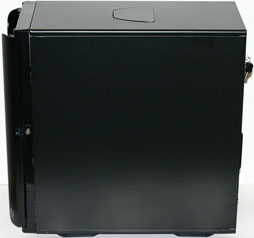 |
 |
| Click to enlarge | |
Similar to the midrange build, the high-end iBUYPOWER system once again has a large window dominating the left side of the case, and there's not much to see on the right side.
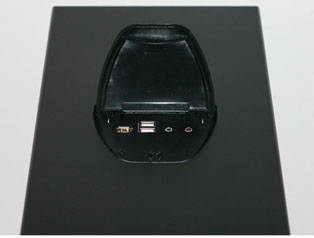 |
| Click to enlarge |
Most modern cases include USB ports and a couple audio jacks on the front of the case, but the Thermaltake design changes things up a bit. A top hatch pops open to reveal two USB ports, a FireWire port, and the microphone and headphone jacks. This type of design is generally best used when placed on the floor rather than on top of a desk, and whether or not you prefer it over front mounted ports is going to be a personal opinion.
 |
| Click to enlarge |
Removing the left panel and taking a look at the Interior, you would hardly expect that these two systems were built by the same company. The change of case and power supply definitely contributes to the reduced cable clutter, but it also seems that iBUYPOWER might have taken a bit more time to make sure the interior was clean on this high-end configuration. The only way verify that would be to purchase a midrange computer with the Thermaltake Armor Jr. case (and probably a different power supply as well), but we'll give them the benefit of the doubt. The Thermaltake chassis certainly has a few more options for routing wires, so clean wiring will depend in part on what type of case you purchase as well as whether or not you get a power supply with sleeved cables. Some companies spend a bit more effort on making sure cables are really kept out of the way, but that sort of approach has other drawbacks -- if you ever need to change out a component, having all of the cables tucked away can make it far more difficult to accomplish.
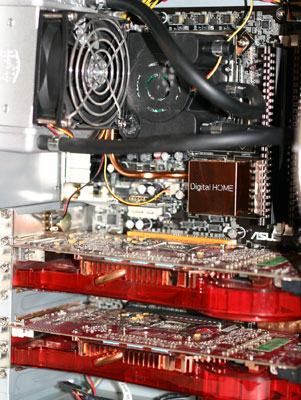 |
 |
| Click to enlarge | |
There are also some other interesting aspects of the internal equipment. For one, there's a small water cooling heatsink on the CPU, although the size of the water reservoir is so small that it's difficult to imagine this will be much better than standard air cooling. (Don't be concerned with the radiator portion appearing to be dislodged -- that was something we had done prior to taking the pictures and forgot to correct.) The fan on the water block also serves as the rear case exhaust, although with only an 80mm fan it's not going to move as much air as a larger 120mm fan would. The mounting of the radiator on the rear of the case is also less than ideal, as the case is designed to accommodate a 120mm fan. Three screws are basically inserted through the honeycomb grill, and a fourth screw can't be used because the honeycomb perforations don't line up with the screw holes.
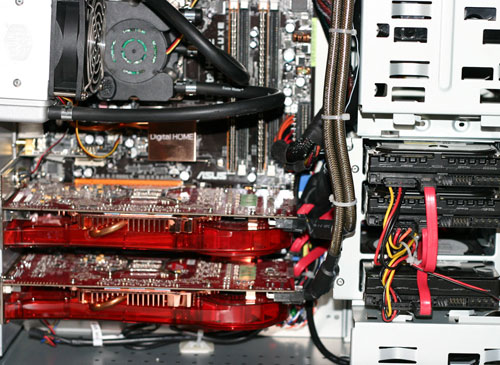 |
| Click to enlarge |
The two large graphics cards at the bottom of the case take up quite a bit of room, and iBUYPOWER didn't elect to install any other optional expansion cards. There's still room to add a sound card if you want, as well as a TV tuner, but it's going to be a bit cramped. That's part of the price you pay for high-end CrossFire or SLI configurations, unfortunately. The dual X1950 cards do have some positive aspects, however (besides performance). Both cards ventilate their hot air out the rear of the case, so they should improve airflow within the case and hopefully not contribute too much extra heat. The Gateway FX530 we looked at offered similar performance, but Gateway didn't use a standard X1950 CrossFire card due to space requirements.
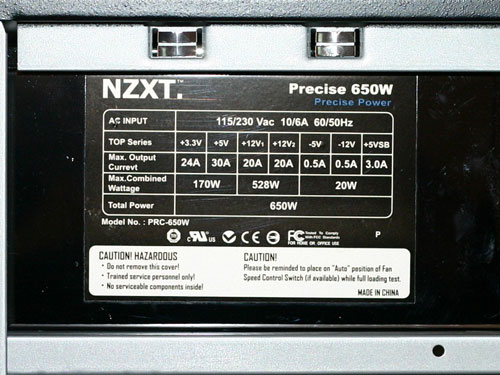 |
| Click to enlarge |
Other than the power supply, the only remaining cooling is provided by the front 120mm fan. This fan also blows air across the three hard drives, so the system should be able to easily accommodate any hard drive configuration you wish to install. The dual Raptor drives along with a third mass storage drive are a good indication of what can be accomplished. The side-mounted hard drives also make it easier to install large graphics cards, and reaching the power and data connections on the drives is a lot more convenient as well. The power supply is still an NZXT model, but at least it has sheathed cables this time. It includes the dual PCI-E power connectors that are necessary for X1950 CrossFire, and there are plenty of other power connectors for the remaining devices in the system. Unfortunately, the power supply did fail during testing, but more on that later.
In contrast to the midrange system, the high-end iBUYPOWER setup is pretty impressive. It uses a better case and the wiring job was much cleaner. Considering that it includes more components, keeping everything uncluttered is even more difficult. Obviously, some time and effort went into putting the system together to make sure everything looked nice. If all of iBUYPOWER's systems looked like this on the inside, we would have no problem whatsoever recommending them, but for now it appears that your choice of case and possibly the price of your system will have an impact on how much effort goes into putting the system together. Perhaps iBUYPOWER should ditch their current 420W default PSU and upgrade all of their systems to something with sheathed cables, as that alone would help quite a bit in making the internals look better. Another option would be to eliminate the case windows, and as we mentioned already we wouldn't mind seeing a few less gaudy cases for selection in the online configurator.










17 Comments
View All Comments
EvErywhErE - Saturday, October 25, 2008 - link
Great Article on Pudget! I stumbled accross them quite by accident last month after my work machine melted down... I was tight for time, didn't want to think about anything, and was planning on doing just a litle internet research to see if anyone could beat Dell for general price, performance, warrenty, and ease of assembly.I was instantly impressed with the pudget website, and the fact that a real person picked up the phone and seemed to know exactly what I needed. I explained that I was an mechanical engineer and that the machine would be used for CAD work about 90% of the time. 10 minutes later I recieved an e-mail link to a custom computer that served as a great starting point. I did just a little customizing and really felt quite happy knowing that I didn't have to spend the rest of my day weighing performance, stability, and an unknown amount of time troubleshooting that one unexpected thing.
I ended up going with an Intel Core 2 Quad Q9400 Quad-Core 2.66GHz, an Asus P5Q-E mother board, Quadro FX 1700, and 4Gig of ram. Not the most amazing machine out there, but more than enough to keep me working for another year or two.
As luck would have it my modest workstation proved to be a nightmare to get up and running... In the end it took a full 4 weeks to get everything up and running. This included some hardware shipping delays, swapping of memory, OS choices (xp64, then Vista 64) swapping the motherboard, and eventually solving the problem with a Bios update.
Needless to say I've gone through many levels of frustration during the whole process, but at the same time I really have felt supported by pudget the whole time. My contact person has been quick with updates most of the time, and has always been good at not making promises that he couldn't keep.
In the last week I've spent so much time researching computer components that I decided to just build my own one more time, and when I realized how huge my mark up was it really did make even more sense. But there really is a bit of irony though because my last machine was painstakingly built up with the help of a knowledgeable friend for the exact same purpose and I had a bios gremlin the haunted me for the past 3 years...
So to bring this long story to a finish, I sent an e-mail to Pudget today saying that after a lot of thought, too much computer research, and of course way too much waiting, I'd decided to cancle the order. This had already been discussed previously and the plan was to make a final decision today. I recieved a very nice call from a manager just an hour or so later who was very sympathetic to the whole situation.
As it turned out my computer had finally made ith though the last phase of QA and was ready to ship. Considering all I'd been through he offered to ship it next day for free and let me demo the machine with an unconditional 30 return and no restocking fee. At the moment I'm still pretty set on the idea of building an SLI machine myself- but at the same time I realized that even in this worst of all imaginable scenerios, I as a customer never felt negleted. That's a really had thing to find these days even in the best of situations, so to find a company that really did manage to fall flat on their face in terms of expectations, but still maintain customer support and confidence is really something that stands out.
About 10 minutes after I got off the phone I recieved an email summary of my newly completed system complete with thermal images in both an idle and loaded configuration. It's just a little touch, but really that is what makes the difference between high quality and useless junk. My new test drive toy should arrive monday morning; I can't decide if I want to to be amazing, or if I want to need a little more. I guess too much geeking out on specs the last week has really started to sink in. Either way it's nice to know that there's a whole crew of people to support me regardless of my decision.
Pudget definately isn't the cheapest, and they don't offer every component known to man, but if you're in the market for a team of people that will take the time to do the job right, and provide quality human interaction the whole way through the process they may be a very good choice.
Metal Face - Monday, February 26, 2007 - link
It looks like Puget may have scrapped their Certified Systems programicthy - Friday, February 16, 2007 - link
I've been considering buying a computer from Puget Systems for some time now, so I was quite glad to see the article. I especially appreciate that you calculated the markup for a computer, although it would have been nice to see some details. Also, I want to mention the reason I've considered Puget Systems is they'll build a top of the line linux computer, which is nice because then you don't have to worry about issues with compatability and cutting-edge hardware. I'd like to offer the friendly suggestion that this would have been a useful piece of information for the article, as it's rather difficult to find a computer vendor that will build something that will be guaranteed for linux.Finally, I'd suggest checking out Envision Computer Solutions for a future article along these lines. I bought a PC from them and was very impressed. (Note: I have absolutely no personal or business relationship with them).
Imnotrichey - Friday, February 16, 2007 - link
yikes, i didnt see that part. 25% markup seems a bit extreme.JarredWalton - Friday, February 16, 2007 - link
Check out VoodooPC, Falcon Northwest, Alienware, and anyone else like that. Some of them seem to be about a 50% markup - and yes, I'm accounting for the cost of their custom paint jobs (where applicable).Imnotrichey - Friday, February 16, 2007 - link
Yes, I'm sure you are correct that this is better than those others. Just surprising to me, since I never looked into it. 5-10% I could understand, but making a 2000 buck system cost 2500 just doesn't seem worth it. Seems like someone would slip under that 25% mark up and force them to compete at that level.JeffDM - Sunday, February 18, 2007 - link
Given the costs of doing business, I really don't think it's extreme.In your example, the $2000 "system" isn't really a system, it is really just a pile of parts. It's part of the $500 extra that makes it into a system, the rest have to go to business expenses. The labor, procurement, warranty and support aren't free. There are a host of other business expenses in there too, running a business is not cheap.
runestone - Saturday, February 17, 2007 - link
I live in the nearby area of Puget Systems, here's my .02: when the A8nE-sli boards came out, they were hard to get. I noticed they had some; called them and got a quote of 275$, well past my threshold of gouging. I found one a day later for 100 less.I guess if you have the money to blow they have some nice systems.
anandtech02148 - Friday, February 16, 2007 - link
good taste, always begins with a computer case. Puget got it.Imnotrichey - Friday, February 16, 2007 - link
I agree, Puget system seems to give you so many top notch choices